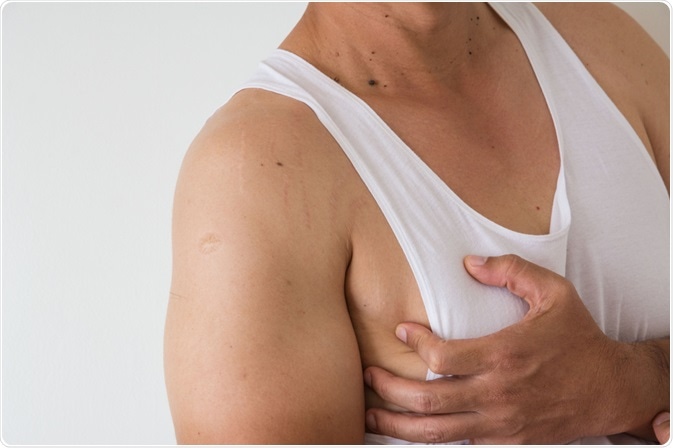Gynecomastia describes the swelling of breast tissue in males, caused by a decrease in the level of testosterone compared with the level of estrogen. The condition can affect one or both breasts and can develop in newborns, during puberty or in older men, usually as a result of normal hormonal changes.
 Image Credit: PRASAN MAKSAEN/Shutterstock.com
Image Credit: PRASAN MAKSAEN/Shutterstock.com
In infants, gynecomastia affects over half of males born due to the effect of their mother’s estrogen and the swollen breast tissue usually disappears within three weeks after birth. During puberty, hormonal changes commonly cause gynecomastia and in the majority of cases, the issue resolves independently after six months to two years.
In older individuals, the condition is more likely to develop between the ages of 50 and 80, with a quarter of this age group being affected. As men become older, their testosterone level tends to decrease and they also tend to gain weight.
The lowered testosterone can cause the breast glands to enlarge and the weight gain means fatty tissue accumulates under the breast, leaving the man with a larger quantity of glandular tissue and more fat in the breast. As fat cells are estrogenic, this additional fat can further disrupt the balance between testosterone and estrogen.
Gynecomastia is not generally a serious issue, although it can be difficult to cope with as it can be painful and cause feelings of embarrassment. The condition can resolve independently of any intervention but if it persists, medication or surgery may be recommended.
Aside from natural hormonal changes, the use of certain medications can cause gynecomastia and examples of these include anabolic steroids, androgens, anti-androgens, anti-anxiety medications, antibiotics, chemotherapy, heart medications and drugs used to treat AIDS. Other causes include the use of substances such as alcohol, marijuana, methodone, heroin and amphetamines; health conditions including hyperthyroidism, kidney failure, liver disease and malnutrition and the use of herbal products such as shampoos, lotions or soaps containing tea tree or lavender.
The symptoms of gynecomastia include the following:
- The main symptom of gynecomastia is the enlargement of either one or both breasts. The enlarged glandular tissue usually occurs in both breasts but in some cases it is unilateral. The breast growth may be uniform or uneven with respect to the nipple. It may feel rubbery or firm. The growth may appear just behind the nipple.
- The breast or nipple may be painful or tender when touched.
- In boys, there may be a breast bud in one or both breasts that is around the size of a quarter or nickel. These commonly occur in boys during puberty and can persist for up to two years.
- It is important to distinguish gynecomastia from male breast cancer. When cancer is present, only one breast is usually affected and the tissue is not necessarily hard or firm. Cancer may also be associated with dimpling of the skin, nipple discharge, retraction of the nipple and enlarged lymph nodes under the arms.
- Another problem that can cause male breast swelling is a breast abscess, although this is rare in men. Affected individuals may develop a fever or chills. The swelling may be very painful and hot to touch and skin across the swelling may appear reddish in color.
Evaluation of gynecomastia symptoms
When examining a male patient with enlarged breasts, a doctor will want to clarify the duration of the enlargement; whether or not secondary sexual characteristics are fully developed; any association between puberty and onset of the enlargement; breast symptoms such as nipple discharge or pain and whether any genital symptoms are present such as erectile dysfunction or lowered libido.
When evaluating the patient, the doctor will look for symptoms that could indicate the potential cause of the enlargement such as weight loss or fatigue which could be caused by kidney disease or hyperthyroidism; discoloration of the skin which could indicate liver or kidney disease; cognitive or mood changes indicative of hypogonadism and hair loss, which could suggest malnutrition.
The patient’s medical history will also be reviewed to check for any disorders that could cause gynecomastia and the use of any medications that may trigger the condition.
GYNECOMASTIA, Causes, Signs and Symptoms, Diagnosis and Treatment.
Treatment of gynecomastia
Gynecomastia usually resolves without any treatment being required, but if the cause is an underlying health condition such as liver disease or hypogonadism, that condition will need to be treated before the breast symptoms resolve. Among teenagers where there is no apparent cause of gynecomastia, a doctor may advise evaluations every three to six months to check whether symptoms are improving. If the condition does not improve after two years or if it is causing significant pain or embarrassment, treatment may be required. A medication to adjust the hormone imbalance such as an anti-estrogen or aromatase inhibitor may be prescribed.
If a patient still experiences bothersome symptoms after monitoring or initial treatment, surgery may be advised. Liposuction may be recommended to remove the breast fat or mastectomy may be recommended to remove the breast gland.
Outlook of gynecomastia
Gynecomastia is not usually associated with long-term problems, but people who develop the condition are at around five times the risk of developing male breast cancer compared with the population in general. This is probably because the hormonal changes that result in gynecomastia are also the changes that increase the risk of male breast cancer.
References
Further Reading